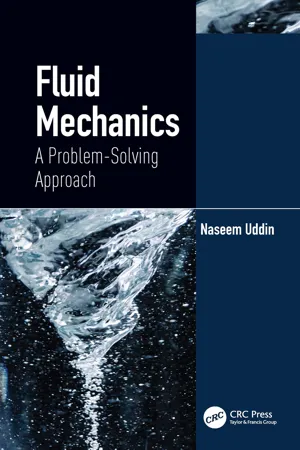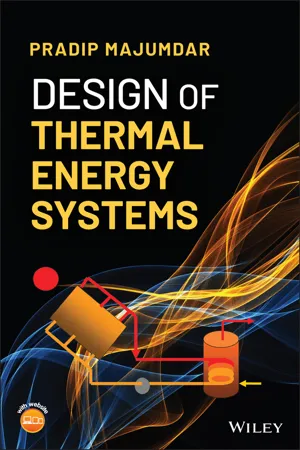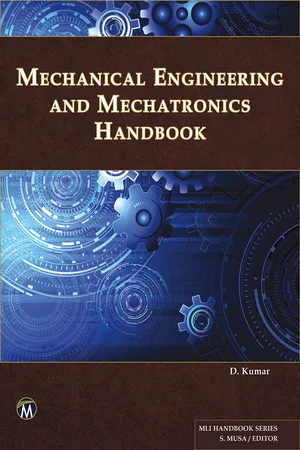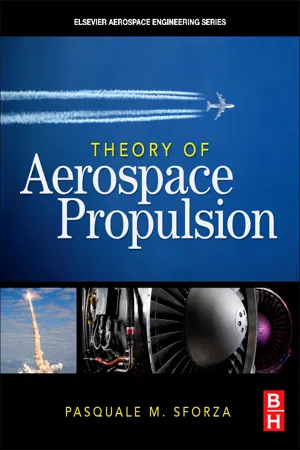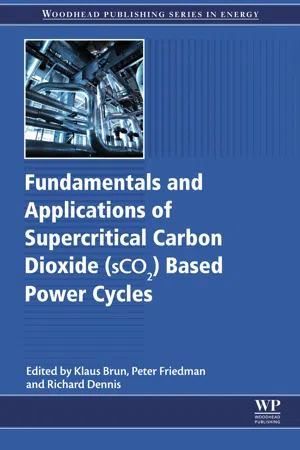Technology & Engineering
Turbomachinery
Turbomachinery refers to machines that transfer energy between a rotor and a fluid, such as turbines, compressors, and pumps. These devices are commonly used in various industries, including aerospace, power generation, and oil and gas. Turbomachinery plays a crucial role in converting energy from one form to another, making it an essential component of many engineering systems.
Written by Perlego with AI-assistance
Related key terms
Related key terms
1 of 4
Related key terms
1 of 3
5 Key excerpts on "Turbomachinery"
- eBook - ePub
Fluid Mechanics
A Problem-Solving Approach
- Naseem Uddin(Author)
- 2022(Publication Date)
- CRC Press(Publisher)
17 TurbomachineryDOI: 10.1201/9781003315117-17Turbomachinery involves a collection of blades or buckets and flow passages that are arranged around an axis of rotation to form a rotor or an impeller. When fluid is used to rotate the rotor and shaft, power is produced; such a device is called a turbine. If electrical power is used to create the shaft work and subsequently energy is added to the fluid to raise its level, then such a device is a Turbomachinery-based pump. In this chapter, the focus is placed on such rotating devices.■■■■■■Learning outcomes: After finishing this chapter, you should be able to:- Formulate the Euler's Turbomachinery equation.
- Know how to use specific speed in selection of turbines and pumps.
- Understand the cavitation phenomenon and its prevention.
- Understand the basic design principles for the energy extraction and energy adding devices.
Turbomachines are mechanical devices that either get energy from a fluid (turbine) or add energy to a liquid (pump)/gas (compressor) owing to dynamic interactions between the device and the fluid. While these devices' actual design and construction usually require significant understanding and effort, their primary operating principles are the same. Fans are one of the most common examples of Turbomachinery devices, in which the air is pushed with a little pressure change across the blades. Cooling fans are not only used in industry, in aircraft, but also used quite commonly in household devices and even in desktop computers to cool the processors (see Figure 17.1 ).Figure 17.1(a) Cooling fan used in computers; (b) compressors are used in gas turbines.Many turbomachines have some housing or casing surrounding the rotating blades or rotor, forming an internal flow passage through which the fluid flows. Not all the devices have enclosed the casings. Some, like windmills, wind turbines, and fans, have no casings around them. Some turbomachines include stationary blades or vanes besides rotor blades. These stationary vanes can be accelerated the flow and thus serve as nozzles. Or, these vanes can be set to diffuse the flow and act as diffusers. - eBook - ePub
- Pradip Majumdar(Author)
- 2021(Publication Date)
- Wiley(Publisher)
7 Rotary Components in Thermal SystemsOne of the major classes of rotary machines are the turbomachines, which are fluid‐handling devices that direct the flow with the aid of vanes attached to a rotating shaft for the purpose of either producing power or increasing pressure. Examples of such turbomachines are turbines and prime movers like pumps, fans, blowers, and compressors. Other types of power‐producing devices like reciprocating piston‐cylinder engine as well as pressure‐increasing devices like gear pumps, are generally not included in the classification of turbomachines. Major distinction is that the turbomachines are rotating machines used to produce power or increase pressure or head of the working fluid. The pressure change is obtained by the combination of centrifugal force and Coriolis force caused due to rotation and change in radius from the inlet to the outlet.7.1 Turbomachine Types
Turbomachines are primarily classified into two groups based on the direction of energy transfer between the fluid and the machine. Group one includes machines in which power is the input as fluid receives energy from the rotating impeller shaft and increases head or pressure. This group includes pumps, fans, blowers, and compressors. Group two includes machines that produce power output, as fluid moves through the machines. This group includes turbines such as steam turbines, gas turbines, wind turbines, and hydraulic turbines.Turbines are used to extract energy from fluids and produce power in two steps: convert fluid energy into mechanical energy through rotating blades in an impeller and shaft, and then convert the mechanical energy into electrical energy by connecting the rotating shaft to an electrical generator. Turbines are categorized based on the type of fluid and the major energy forms available for conversion. For example, steam turbines are used for converting thermal energy from steam; gas turbines for converting thermal energy from high temperature and pressure gas; water turbines for converting potential energy of water; and wind turbines for converting kinetic energy of wind. Among the prime movers, pumps are used for moving liquids and slurries and creating increase in pressure; fans and blowers are used for moving gases and vapors while creating small pressure rise; and compressors - eBook - ePub
- D. Kumar, Sarhan M. Susa(Authors)
- 2022(Publication Date)
- Mercury Learning and Information(Publisher)
6HYDRAULIC MACHINESPower engineers are primarily concerned with the design, fabrication, installation, operation, and maintenance of fluid machines that function to affect an exchange of energy between a fluid medium and a mechanical system. In the fluid-mechanical system either the machine does work on the fluid or conversely, the fluid imparts work to the machine. The wide variety of fluid machines that have been built up to affect a transfer of energy to or from a fluid medium can be broadly classified into two main types; the dynamic or kinetic type; and the displacement or static type.1. Dynamic or kinetic machine in which mechanical work is done on or by the fluid entirely as a result of dynamic or kinetic action between a fluid and a rotating system of blades. The energy transfer is accompanied both by pressure and momentum changes. Examples of dynamic machines, also called the turbomachines are:● water, steam, and gas turbines,● pumps, fans, blowers, and compressors,● propellers, windmills, and unshrouded fans, and● fluid coupling and torque converters.In these bladed machines, an impervious boundary containing the fluid does not exist at any time. Further, the operation of these machines is both steady and continuous.Turbomachines can be identified as power generating, power absorbing, and power transmitting machines. In a power generating turbomachine, the energy of the incoming fluid is transferred to the rotating element which in turn may drive another machine. These machines produce power by expanding fluid to low pressure or head; there is a conversion from static pressure to kinetic energy. Examples of power generating machines are water, steam, and gas turbines. In a power-absorbing turbomachine, the rotating element imparts energy and thereby increases the pressure or head of the outgoing fluid; there is a transformation from kinetic energy into static pressure. Pumps, ducted fans, blowers, and compressors are notable examples of power-absorbing machines. In a power transmitting turbomachine, the energy of one rotating shaft is first transferred to the fluid which in turn transfers the energy to another shaft; this may result in a change of speed and torque. The best-known examples of power transmitting machines are fluid couplings and torque convertors. These machines are used for power transmission in automobiles and trucks, and industrial machines. - eBook - ePub
- Pasquale M. Sforza(Author)
- 2011(Publication Date)
- Butterworth-Heinemann(Publisher)
Chapter 7. Turbomachinery7.1 Thermodynamic Analysis of a Compressor and a Turbine2387.1.1 Compressor thermodynamics2407.1.2 Turbine thermodynamics2417.1.3 Units used in compressors and turbines2427.2 Energy Transfer between a Fluid and a Rotor2437.2.1 Velocity components and work in turbomachines2467.3 The Centrifugal Compressor2487.3.1 Axial entry centrifugal compressor2507.3.2 Example: Centrifugal compressor2527.3.3 Pressure coefficient2537.3.4 Effects due to number and shape of blades2557.3.5 Guide vanes, diffusers, and volutes2607.4 Centrifugal Compressors, Radial Turbines, and Jet Engines2627.5 Axial Flow Compressor2637.5.1 Velocity diagrams2647.5.2 Pressure rise through axial flow compressor stages2667.5.3 Types of compressor stages2687.5.4 Compressor stages2717.5.5 Example: Axial compressor stages2747.5.6 Polytropic efficiency of adiabatic expansion2757.6 Axial Flow Turbine2767.6.1 Velocity diagrams2767.6.2 Pressure drop through axial flow turbine stages2777.6.3 Example: Turbine pressure drop2787.6.4 Types of turbine stages2797.7 Axial Flow Compressor and Turbine Performance Maps2837.7.1 General aerodynamic considerations2837.7.2 Turbine performance maps2867.7.3 Compressor maps2897.8 Three-Dimensional Considerations in Axial Flow Turbomachines2947.9 Nomenclature2967.9.1 Subscripts2977.9.2 Superscripts2987.10 Exercises298A general thermodynamic analysis of a compressor and a turbine is carried out, and details of the energy transfer between a fluid and the rotor through which it passes are derived. Operation and performance of a centrifugal compressor are developed. The application of centrifugal compressors and radial turbines to jet engines is covered. Operation of the axial flow compressor, which is the most widely used for aerospace propulsion, is analyzed in detail. The velocity diagram for, and pressure rise in, an axial flow compressor stage is derived, and the benefits of using multiple stages are detailed. The axial flow turbine is treated in equivalent detail. The characteristic axial flow compressor and turbine performance maps are developed in depth, and three-dimensional considerations in axial flow turbomachines are discussed. - Klaus Brun, Peter Friedman, Richard Dennis(Authors)
- 2017(Publication Date)
- Woodhead Publishing(Publisher)
Fig. 7.2 over a realistic range of compressor and turbine efficiencies (turbine efficiency was held fixed at 87.5% as compressor efficiency varied, and compressor efficiency was fixed at 82.5% as turbine efficiency was varied). The results show that every two points of efficiency increase in the turbine results in approximately a one-point increase in cycle efficiency, while the impact of compressor efficiency is approximately half that. These trends are nearly linear over a typical range of machinery efficiencies. While the exact values will change for different cycle configurations, these trends will be similar.Off-design performance of the Turbomachinery will influence the part-load efficiency, operation strategy, and limits for the cycle based on the efficient and stable operating ranges of each component. As with other applications, start-up and shutdown procedures must also account for off-design machinery performance to avoid damaging conditions such as surge, operation at critical speeds, or overspeed. Finally, the mechanical design of the turbine(s) in particular may also affect the ability to execute fast thermal transients in the system, although transient thermal stresses in the recuperators and primary heat exchangers must also be considered.This chapter describes the operating requirements, challenges, and various design concepts for Turbomachinery in sCO2 -based power cycles. Section 7.2 describes the machinery types required for various cycle configurations and discusses the impact of Turbomachinery designs on cycle performance and flexibility. An overview of existing prototype Turbomachinery in various laboratory facilities is provided along with a review of Turbomachinery configurations and designs in the literature for various applications in Section 7.3 . Section 7.4 focuses on challenges common to all sCO2 turbomachines including rotordynamics, pressure containment, sealing, and transient/off-design operation with a description of specific components including bearings and seals. Sections 7.5 and 7.6 discuss compressor/pump- and turbine-specific design attributes and challenges, and a summary discussion is provided in Section 7.7 .Figure 7.2 Dependence of cycle efficiency on Turbomachinery efficiency (simple Brayton cycle).7.2. Machinery configurations
Index pages curate the most relevant extracts from our library of academic textbooks. They’ve been created using an in-house natural language model (NLM), each adding context and meaning to key research topics.
Explore more topic indexes
Explore more topic indexes
1 of 6
Explore more topic indexes
1 of 4
